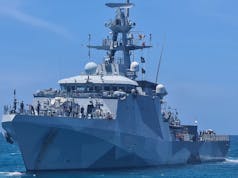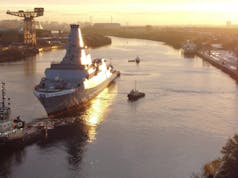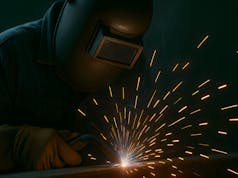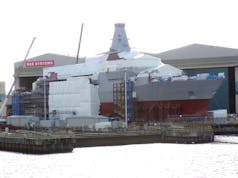The remarks came at the conclusion of Exercise Saxon Warrior 2017, the US and UK-led multinational exercise designed to hone carrier operations.
Saxon Warrior provided invaluable training between the US and UK CSGs as the exercise is designed to ‘develop theatre-specific combat skills and develop their expertise for real-world multinational operations’.
“Saxon Warrior allows us to develop our warfighting capabilities with our most trusted partner, the United Kingdom,” said Rear Adm. Kenneth Whitesell, commander, Carrier Strike Group 2. “With the U.K. soon bringing HMS Queen Elizabeth, followed by HMS Prince of Wales, the combined carrier force of our partnership will grow to rapidly and credibly handle the full spectrum of warfighting worldwide. Saxon Warrior presented an opportunity to train against a wide variety of threats, and gain confidence that we can answer the call against emergent situations anywhere in the world, we can tackle it together as partners.”
The ten-day exercise which took place off the coast of the United Kingdom was presented in phases. The initial phase presented single-mission scenarios encompassing surface, subsurface and air combat. The exercise also encompassed maritime security operations such as counter-piracy operations and other scenarios that tested a large number of combat skills.
“Saxon Warrior was a perfect platform to test how far we’ve come because we started from scratch,” said Royal Navy Lt. Cmdr. James Capps. “We’re trying to get in a position that when the Queen Elizabeth comes online, we can operate her as an embryonic carrier strike group and develop that towards the future when we go out the doors as fully-fledged carrier strike group.”
According to the US Navy:
“The exercise culminated in a multi-mission simulated war that tested every aspect of the warfighting capabilities of the US and UK CSGs. Multi-national aircraft squadrons practised flight operations, air-to-air engagements, long-range strikes and close support of surface combatant ships.”
“Saxon Warrior gave us a challenging environment in which to use our warfighting skills,” said Capt. Benjamin Nicholson, commodore, Destroyer Squadron 22 (CDS 22). “Our ships learned to work in unison with our allies, and became the cohesive unit that we were expected to be.”













Good work all round and kudos to the US for helping us out with this.
It’s good we are now looking at carrier based air to air refuelling we should also be looking at carrier based fixed wing AWACS perhaps the same type of aircraft can be used.
Due to the ski ramp and lack of cats and traps our choices are somewhat limited. Osprey and er Osprey…..
One can only dream the MoD has the foresight and wherewithal to commit to an Osprey batch purchase. I wouldn’t bet any amount of money on it all; although I’m not too sure what else there is as a carrier based alternative . Did I read somewhere the F-35s can be fitted with the equipment to perform air-to-air refueling?
Any aircraft with wing pylons or underbelly mounts can be an A2A mini tanker. US F-18 Hornets do it every day, we had Buccaneers doing it in the ’60s so it is not new or clever. Personally I have always thought the 4 F-35 T & D ‘mules’ we have in the USA should be converted to refuellers (as they will never see combat) and we have 2 per ship bought and paid for.
As a personal view again I think we should repatriate all our F-35s to the UK (Marham) and operate all development from here. Far cheaper. The risk is we become too dependent on the USMC ‘way’. Good as they are we are at our best when we have to think on our feet for ourselves.
As for Ospreys? Well nice idea but way too expensive for what they offer. Airlift? We have Merlins or Chinooks. Tanking? See above. Air defence? Well given the AC’s own capabilities plus Type 45 and the Merlin mounted ‘Crowsnest’ system what would an Osprey add apart from height? And doesn’t the F-35 itself have some of the most advanced airborne sensor systems? Add Captor-E to those 4 T & D aircraft as well? All far cheaper and just as effective as Ospreys. Just floating ideas here by the way.
The Osprey, for refuelling or AEW, adds endurance… A fixed wing aircraft can generally travel faster than a helicopter, and has greater endurance. Plus the Osprey with a palletised refuelling system including additional fuel could carry more than an F-35, and wouldn’t be using up expensive flight hours – This is one of the reasons the USAF are having to buy more F/A-18s – They’re using up so many airframe hours on buddy refuelling!
OK, For USAF, Read US Navy – It’s been a long day!
Rob – well not quite if you actually think about it rather than assume a negative and then argue that point.
I was purely answering the question about fixed wing aircraft. If you have read any of my posts about the QE you will have seen that I am very positive about its potential.
Agree that the best way of achieving A2A refuelling and airborne sensors is to use the F35Bs themselves. The last thing we need is to stretch the budget further by purchasing different air frames.
You don’t need AWACS when F-35 can perform that function. Dedicated AWACS on aircraft carriers is a legacy capability.
Osprey for air2air role. Long range, good payload. Only issue is coat. The RN would only need a small number for refuelling duties say 6-9.
The air to air refuelling is an interesting question, Chris is right about converting some f35’s, could be an option, the osprey is an option but an expensive one, perhaps the American’s could loan us two for an operation.
We seem to be getting more and more interoperable with the US Navy so lending stuff like that for deployments is not totally out of the question.
They put us in charge of one their task groups recently and put US Marines under Royal marine command in the Iraq war.
Okay, it’s a tenuous link, but I wish the US Defence Department would reconsider closing RAF Mildenhall, a first class airfield with strong historic links. It’s good to hear that the UK is judged to be dependable, but surely that means strengthening our mutual operations, and not closing them down?
The US is swinging to face off against China/ North Korea. Russian threats will be considered a European issue and something NATO members in Europe need to face upto. The RN needs enlarging back upto 26 frigates and destroyers. A few heavy cruiser sized vessels would also go down well. 10 nuclear attack submarines. Fantasy fleet time maybe, But i can live in hope.
Hmm, the Osprey. It’s killed more men that the L85.
In an “ideal world” the RN would buy the V22, ( the one where the sun always shines and money is no problem) the Royal Navy would buy the same variant the US Navy is buying for COD.
Such a variant with added AAR capabilities would be a huge force multiplier for the Carriers.
Especially if AAR probes were installed on some Chinook and Merlin Transports ( designed for, but never fitted to Merlin) .
This would allow true over the horizon assault and give some symmetry with the Americans evolving philosophy of Amphibious operations.
Meanwhile back in the real world … We need buddy tanking capacity for the F35B and external fuel tanks at the very least.
The Americans could of course lease us some V22’s…..
Come on Uncle Sam, how about it?
AAR coupled with Rolling Vertical Landing techniques, would go a long way to closing the supposed capability gap with Conventional Carriers.